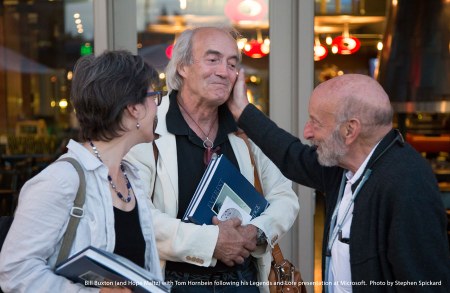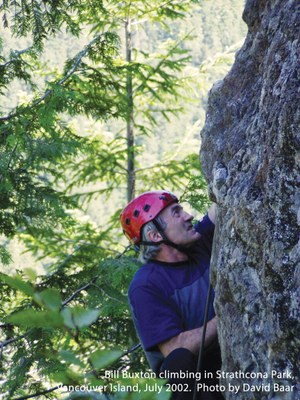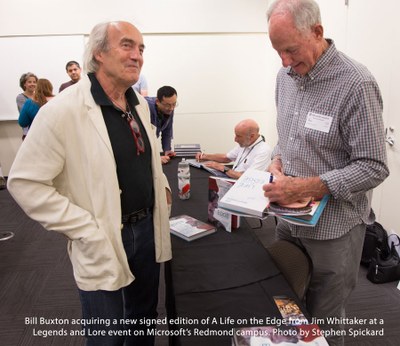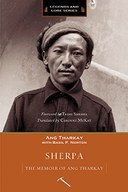
by Lace Thornberg, Director of Development and Communications, Mountaineers Books Braided River
When asked “How many books are there in your mountaineering library?,” Bill Buxton replies in feet, not number of volumes. His collection of mountaineering books takes up “65 linear feet” of his Toronto home.
Canadian computer scientist and designer Bill Buxton is a pioneer in the field of human–computer interaction. In 1970s, he began making his own digital musical instruments, work that led him to his first career role at Xerox PARC. As Chief Scientist of SGI and Alias|Wavefront, he worked with some of the top film makers and industrial designers in the world. After serving as a professor at the University of Toronto and the Ontario College of Art and Design, and principal of his own boutique design firm, he was named Principal Researcher at Microsoft Research in 2005, and has split his time between Redmond, Washington and Toronto, Ontario since then. The Mountaineers are proud to count Bill, who holds four doctorates, as a supporter.
Human-computer interaction may be Bill’s core passion, but his admiration for mountains runs nearly as deep. “When I was 11, our family moved to Victoria, BC, to a part of town called Oak Bay. On my first day going to my new school, I remember riding my bicycle down a hill and seeing the Olympic Mountains.” He recalls being awestruck by the sight as he pedaled on.
“When I returned home from school that day, I told my father, ‘This weekend I am going to go over and climb those mountains.’ My father commented that it would be a fairly long ride to reach them, and that the Strait of Juan de Fuca might prove difficult to cross by bicycle.”
Although Bill caught the mountain bug early, he never lived close enough to the mountains to make climbing a regular activity as a young adult. “Back then, I was more interested in music and running anyway. I wanted to go to the Olympics [the games, not the mountains] and I wanted to be a professional musician.”
When he could get into the mountains, hiking, scrambling, and skiing were his main outdoor pursuits. Though he had begun reading voraciously about climbing expeditions, he didn’t go on expeditions himself. “I became an armchair mountaineer,” he says. It wasn’t until he entered his fifties that he started rock climbing and mountaineering.
Bill feels fortunate to have roped up with a number of talented climbers since then, including Pat Morrow (the first person to climb the Carstensz-Pyramid version of the Seven Summits) and Barry Blanchard (an elite alpinist known for highly technical, high-risk alpine climbing in the Canadian Rockies and the Himalayas). As he says, “My time in the mountains has been dominated by time with people so out of my league, it’s not even funny.”
“For whatever reason, they have tolerated me,” Bill says humbly, adding, “The people I climbed with didn’t care how hard you climbed. What they cared about was the quality of the company and the day.”
“After Barry Blanchard reminded me that the best mountaineer in the world is the one who is enjoying it the most, I realized I could be ‘world-class’ just by having fun.”

Avid mountaineering literature collector that he is, it was only a matter of time before Bill crossed paths with Mountaineers Books. Publisher Helen Cherullo met him in 2005 at the Banff Mountain Book and Film Festival, where Bill was on the book jury. On meeting, Bill immediately turned the conversation to why The Mountaineers should publish a translation of Ang Tharkay’s autobiography. A few years later, Mary Metz, editor of Legends and Lore series by the Mountaineers Books, also encountered Bill, in her case, online by way of his web pages on the mountaineering and exploration.
As Mary puts it, “The day I discovered Bill Buxton’s website I felt like I’d discovered a gold mine.”
Bill’s website includes a comprehensive “Dramatis Personae of the History and Exploration of the Greater Himalaya, Karakoram, Pamirs, Hindu-Kush, Tibet, the Indian Sub-Continent, Afghanistan, High Tartary and Surrounding Territories, up to 1921.” Bill describes this annotated list as “a snapshot of my mental model” of all the relationships between the explorers of that era. He made the list for his personal use, but decided that once he had compiled it, he might as well share it publicly.
Some years after Mary had discovered Bill’s treasure trove of information online, Bernadette McDonald, author of Brotherhood of the Rope and Freedom Climbers, and friend of Bill’s, connected him with Mary personally.
Mary had established a team of knowledgeable climbers and authors to serve as an advisory council for her Legends and Lore series, and she invited Bill to join in 2014.
Bill appreciates our Legends and Lore series because it makes mountaineering literature accessible and more easily shared. “With the first [Legend and Lore] books, I didn’t register that they were part of a series. I just knew that I’d found books that had been hard to find before, or that had been too expensive,” says Bill. With Legends and Lore series books readily available, Bill can lend books out to friends, jot notes in the margins, and travel with books all without worrying about losing or ruining a collector’s edition.
After joining the council, Bill helped Mountaineers Books promote the Legends and Lore series by arranging a presentation by fellow advisor Tom Hornbein (author of Everest: The West Ridge) on the Microsoft campus.
By then, Mary and Bill were deep into discussions about Ang Tharkay’s biography. Once he’d learned that Mountaineers Books was finally able to publish an English version of Ang Tharkay’s biography, he says, “There was no way that I wasn’t going to engage, full on!”
“In the many books about the Himalayas, the voice of the people who actually lived there is silent,” explains Bill, “The stories that populate the literature are all from the ‘tourists’.”
Guided by extensive research into the subject over the past two decades, Bill believes that out of the hundreds of books on early Himalayan exploration, only four books contain the firsthand perspective of a local resident: two “as told to” autobiographies from Tenzig Norgay (Tiger of the Snow and After Everest: An Autobiography), Rassul Galwan’s Servant of Sahibs, and Mémoires d’un Sherpa by Ang Tharkay. Of these four mere books that will ever exist, only three were available in English.
Born in 1908, Ang Tharkay was one of the leading Sherpas of the exploration period of the Himalaya. He was a regular on expeditions by Eric Shipton as well as sirdar for the successful French ascent of Annapurna, the first ascent of an 8000-meter peak. He was also on the 1951 Everest Reconnaissance — the trip on which Shipton met Edmund Hillary that in turn led to Hillary’s place on the historic 1953 first-ascent team. Ang Tharkay opened his own guiding service in 1954, taking trekkers up Kangchenjunga, although he also continued to work for some high-level mountaineering expeditions. His memoirs recount his exceptional life with candor.
Like Bill, independently, Mary had searched high and low for an English language translation of Tharkay’s book, but couldn’t turn one up.
There was no doubt that Tharkay’s voice would be a worthy addition to the Legends and Lore series, but, with limited funds available, the cost of translating the original text from French would put it beyond our reach to publish. When Metz broke this news to Bill, he offered to make the translation possible by making a personal donation to Mountaineers Books that covered most of the translation fee.
Bill describes his deep motivation for making that gift in this way: “It wasn’t voluntary. It was compulsory. It was absolutely the right thing to do.”
Ang Tharkay’s biography represents “one quarter of the literature that gives the perspective from the other side,” Bill noted, “It’s so critical that these perspectives be shared.”
Bill further aided in the process of publishing the first English language version of Ang Tharkay’s biography by reviewing the translation and, with the able assistance of his friend Bob A. Schelfhout Aubertijn, providing explanatory endnotes for many of the details in the original that would otherwise have been perplexing for modern readers, compiling a time-line of expeditions, and extending and annotating the brief bibliography of the original. “The two were like kids allowed the run of a candy store,” notes Metz. “A couple of incredibly knowledgeable and insanely generous kids.”
And, when the Mountaineers Books long-awaited English language version was published in March 2016, Bill, who has given hundreds of presentations about design and technology in venues around the world, came to Seattle to speak at our official book launch party for Sherpa: The Memoirs of Ang Tharkay.
At that event, more than fifty Mountaineers members and climbing history buffs were treated to an intimate presentation by Bill, held in a bookcase-lined room at Folio. At this event, Bill and Tashi Sherpa shared their thoughts on Ang Tharkay’s biography — Bill spoke from a historian’s perspective, while Sherpa shared anecdotes and opinions as a family member. Tharkay, a legendary figure much revered by the younger generation, was Sherpa’s uncle.
Presenting Sherpa to an appreciative audience, which included Jim Whittaker and Dianne Roberts, was a joyful step in a journey that had begun many years before.

 Lace Thornberg
Lace Thornberg
